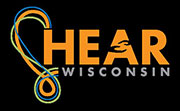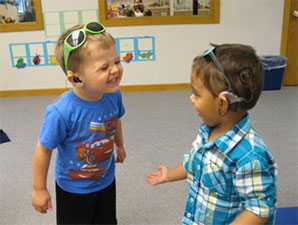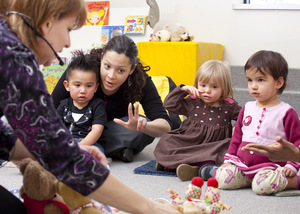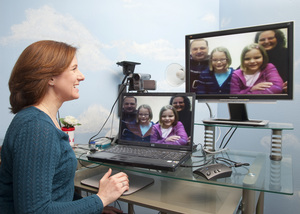HEAR Wisconsin
Factor 4 Program Highlight
 |
Program Overview

Developed by Christine Kometer and Amy Peters Lalios
HEAR Wisconsin, formerly The Center for Communication, Hearing and Deafness is a private, nonprofit agency that has been in existence since 1926. It provides services for children (as well as adults) throughout Wisconsin. The center is one of the only specialized hearing centers of its kind in the country, where all individuals who are deaf or hard of hearing, from infants to the elderly, can find comprehensive programs and services that enhance communication and promote independence. The Language Access Team of HEAR Wisconsin provides services across the continuum of communication and technology options. The Language Access services are provided via a diverse team of professionals, including speech-language pathologists, audiologists, sign language interpreters, and certified auditory-verbal therapists as well as other specialists in deaf education and assistive technology.
Services and Programs
Language Access Team members are providers for Wisconsin's Birth-to-Three program, the state-wide Part C early intervention program for infants and toddlers with developmental delays or disabilities and their families. The Wisconsin Department of Health and Family Services oversees the Birth-to-Three program, and each county in Wisconsin is responsible for providing these services within their respective county. The Language Access Team works with many counties in southeastern Wisconsin to provide appropriate early intervention services to the children who are deaf or hard of hearing in their Birth-to-Three programs. The Language Access Team also works with families who opt not to participate in the Part-C Birth-to-Three program. The Language Access Birth-to-Three services provide a broad array of therapies and education for families with children who are deaf or hard of hearing as well as for deaf parents with hearing children. Services may be provided at HEAR Wisconsin or within a variety of natural environments, such as in the home or in childcare settings, and are tailored to meet the needs of each family.
The goal of Birth-to-Three services is to guide families in understanding that the first three years of life are critical for language development and to empower families to make educated decisions and to advocate for their child. The programs and services are designed to share accurate and unbiased information to provide families with the personal support, education, and resources to give their child a strong foundation in language and communication, whether that communication uses spoken and/or signed language.
Birth-to-Three Programs and Services
In-Home Services
These services are designed to meet the needs of each family. Families are provided with education and resources on a variety of topics instrumental in helping them become advocates for their child's language and communication development. Families are provided with services from one or more professionals with expertise in differing disciplines to enhance their skills in facilitating their child's language and communication development (whether using listening and spoken language and/or signed language).
Community Toddler Communication Groups
Community Toddler Communication Groups are provided at HEAR Wisconsin to facilitate an opportunity for children who are deaf or hard of hearing to interact with same-age peers. Groups are composed of approximately eight children ranging in age from 15 months to 3 years. Space is reserved for hearing peer role models to promote a natural learning environment. Two different communication groups are offered, with a focus on either listening and spoken language or Total Communication. Group placement is individually determined based on the goals of the child and family.
Each toddler group is staffed by teachers, speech-language pathologists, and teacher's assistants who have credentials and/or expertise in a specific communication approach and are available to facilitate development of auditory, speech, language, pre-academic, literacy, and social communication skills within a language-enriched natural play setting. Teaching assistants who are deaf or hard of hearing themselves and use the communication mode and language of the group provide positive role models. Staff-supervised university graduate students majoring in speech-language pathology or another professional related field regularly participate to complete their academic requirements. In addition, a Language Access Team teacher of the deaf and hard of hearing with Kindermusik background provides music activities monthly. Staff has knowledge and familiarity with the variety of listening technologies that individual children may be utilizing: digital hearing aids, bone-conduction hearing aids, cochlear implants, and assistive listening devices. The room has many adaptations to promote an optimal acoustic environment.
The children and adults in each group all use the same communication approach. The toddler groups reflect evidenced-based learning practices designed to meet the unique needs of children who are deaf or hard of hearing. Monthly themes related to a child's daily routines and experiences offer opportunities to expand a child's language foundation. A variety of learning activities related to the theme may include songs, finger-plays, books, storytelling, table time, and sensory activities.
Parents attend the toddler communication group. They are involved in the opening activity of the group and then leave the room to observe through a two-way mirrored observation room. Children leave the group and join their parent for a scheduled individual speech-language session. These sessions focus on the child and family's individual goals, outcomes, target skills, and strategies. The sessions are parent-focused sessions in which the parent is coached in learning and applying the techniques and strategies to encourage his or her child's language, auditory, and speech development to meet developmental targets. Most families that participate in the toddler communication groups also receive home visit services to assist with carry-over of targets, techniques, and strategies into daily activities.
Speech-Language Therapy
Speech-language therapy is provided as a component of both toddler groups; families of children who are receiving speech-language therapy actively participate in an individual half-hour session with a speech-language pathologist. Additionally, families not participating in a toddler group may participate in speech-language therapy as a component of their child's services. These sessions focus on increasing auditory, language, communication and speech, and skills based on individualized goals for the child as well as on coaching and guiding parents for carry-over activities.
Listening and Spoken Language (LSL) Therapy
LSL focuses on facilitating spoken language through listening. LSL practices are guided by specific principles and practices that focus on listening as the primary input for learning language and teaches parents of children who are deaf or hard of hearing how to develop their child's ability to learn through listening. Services are provided by listening and spoken language specialists, certified auditory-verbal therapists and educators who have extensive training and experience. During sessions, the parent, child, and therapist engage in activities that teach the child to meaningfully use sound as made accessible by hearing aid(s) or cochlear implant(s). LSL therapy is available at HEAR Wisconsin or as part of the center's tele-intervention service called ConnectHear(see below for more information).
Parent/Family Link
The Family Link program is intended to bring families together, regardless of communication and language choices, for discussion, information sharing, and support through monthly events, outings, and various activities.
Support Groups/Education Workshops
Family education provides opportunities for open-ended and/or facilitated discussion with other parents of a similar-age child and/or hearing and communication backgrounds. Educational workshops are designed to cover topics of interest to a broad range of parents through guest speakers and panel discussions that are held throughout the year.
The Parent Resource Center
The resource center provides access to books, DVDs, videos, and other materials related to hearing, language, communication, parenting, and Deaf culture. Internet access is also available to provide a link to additional resources and articles. Materials can be borrowed free of charge.
Parent/Child Sign Language Classes
Classes are offered at the center throughout the year to help parents, caregivers, and teachers learn to communicate more effectively with children in sign language. Classes are taught by deaf instructors and class sizes are kept small.
Family Learning Vacation (FLV)
FLV is an event sponsored by the center where families with children who are deaf or hard of hearing from all over Wisconsin gather for a weekend of fun, friendship, and interesting workshops.
Developing the IFSP

The Language Access Team of HEAR Wisconsin (LAT-HW) gets most of its referrals from the county's Birth-to-Three programs. If a child lives in Milwaukee County, LAT-HW becomes the service coordination agency as well. For children in other counties, that county assigns a service coordinator and contracts Language Access services for the assessment and Individualized Family Service Plan (IFSP). Typically, a Language Access teacher of the deaf and a speech-language pathologist will perform the initial evaluation in the family's home using both standardized tools and criterion-referenced checklists to assess the child's current levels of development. (If other developmental evaluations are indicated, the service coordinator will arrange for other therapists to perform those evaluations as well.) The assessments are completed as a team through parent interview, direct interaction with the child, and use of professional observation as well as audiological and other medical record review. Through discussion with the parents/caregivers about their child's current development, the initial IFSP is written with outcomes reflecting the parents' desires for their child and family in the near future.
Communication mode discussions are not necessarily addressed in this initial assessment. Since the Language Access Team has the philosophy and the resources to accommodate various communication and technology approaches, it is not necessary for the family to make a choice about which approach to use before beginning services. The education surrounding these approaches is an integral part of the early intervention services provided. A critical part of the family education process involves assisting families in understanding their child's hearing abilities using information from the audiogram, audiology report, other medical reports, and various resources. Families also have the opportunity to meet other families who have children who are deaf or hard of hearing as well as older children, youth, and adults with varying types and levels of hearing, communication modes, and language choices.
Planning to Support Spoken Language
In discussion of the various communication approaches, Language Access staff utilize a variety of resources. Brain development research is discussed to guide families in understanding the importance of early stimulation for development of language and auditory skills during this critical period of development, and the importance of a child having early and abundant "access" to the desired language to facilitate its development.
The use of expressive and receptive communication continuums has been found to be beneficial in beginning the discussion of the various communication approaches used by many people who are deaf or hard of hearing. Use of this tool helps take some of the confusion of methodologies out of the discussion. Parents can think about how their child is receiving and expressing information currently and how they would like to see their child communicate in the future ... with the family, in school, and later in life. In addition, the North Carolina Beginnings Chart of Communication Approaches www.ncbegin.org is used in a discussion of "what it takes" for a child to be successful with each communication approach. For choices that include listening and spoken language development, the need for consistent use of amplification technology and integration of learning to listen techniques are discussed. For choices that include any use of sign language, family commitment to learning and consistent use of that language or system are discussed.
Parents are encouraged to take some time to research, think about, and discuss with those close to them as well as to meet others who use the various communication approaches before deciding what direction their family would like to take. Once the family makes a communication choice, then strategies and techniques specific to that choice can be added into the individual services. They are assured that their decision is not "cut in stone." All of the Language Access ongoing services are diagnostic in nature. Every visit is an opportunity for the parents and interventionist to observe what the child is doing, how he or she is progressing, what factors are influencing the progress or lack thereof, and what can be addressed to effect any changes desired. Language and listening developmental curricula and checklists are used to track the child's progress. Parents are always aware of how their child is progressing. If something does not seem to be working as desired, changes can be made in strategies or technology as well as in communication mode or language.
Spoken Language Considerations
The Language Access Team of HEAR Wisconsin supports families in helping them to understand the following three considerations that are essential to developing listening and spoken language. These considerations and associated skills are essential to effectively facilitate the acquisition of listening and spoken language regardless of the level of emphasis an approach may have on spoken language:
- ongoing comprehensive audiologic assessment of a child's hearing abilities, with and without amplification technology, to assist in identifying and monitoring appropriate auditory access as related to listening and spoken language goals;
- consistent use of appropriate, optimally fit, functioning amplification; and
- development of family competence/involvement in facilitating spoken language.
1. Ongoing comprehensive audiologic assessment
Most of the children who receive services through the Language Access Team receive audiological services through the Children's Hospital of Wisconsin. Regular and consistent audiologic care and assessment is necessary to confirm the stability of hearing status and ensure appropriate functioning of amplification technology. It is critical to understand a child's hearing status and his or her access to the sounds, communication, and language within his or her environment. Any change in hearing status can dramatically impact access to sound, to language, and prohibit progress. The Language Access professionals collaborate with the child's audiologist via e-mail, phone conversations, exchange of records, and sometimes even attending the audiology appointments with the family. In this way, the audiologist can be kept informed on how the child is using his or her technology, what he or she is responding to in everyday use, and how he or she is using sound meaningfully. This information can assist the audiologist in determining if the hearing technology is programmed appropriately, if adjustments are needed, or if other technology could be beneficial. Quality audiological management provides families and professionals with the information necessary to determine appropriate effective services and allows for informed decision making.
2. Fitting and consistent use of appropriate, functioning amplification
The Language Access Team recognizes the importance of working with families so they understand the integral role of consistently functioning amplification on the development of listening and spoken language skills. It is important that families understand the close relationship of their child's consistent access to sound on the development of listening and spoken language. Associated with this, Language Access professionals provide families with the skills to monitor their child's technology and amplification devices. Parents are encouraged to perform daily checks of their child's hearing aids and/or cochlear implants--both physical checks of the equipment and checks of how the child is functioning with the device(s). The parents/caregivers are taught how to observe their child's auditory responses and functional listening abilities as well as how to troubleshoot any problems.
Many children are able to benefit from the use of hearing technology. We work with families of children utilizing varying amplification technologies, such as hearing aids, BAHAs, cochlear implants, and FM systems. We assist parents and family members in documenting their child's progress with their devices and build their skills as they develop listening and spoken language. For families who choose to investigate cochlear implant/s for their children, we support them as they learn about this technology, go through the candidacy and implantation process. We assist families with expectations and strategies related to their child's listening and spoken language goals as the child transitions to having increased access to sound through his or her cochlear implant.
3. Family involvement
Families and parents are in the unique position to have the most influence regarding a child's early experiences and learning. They are pivotal to a child's growth in all areas of development. While the Language Access Team has an unending passion for young children who are deaf or hard of hearing, their parents are recognized as our primary clients. Parents are the decision makers, including how spoken language will fit with the identified goals of the family and the communication and language approaches pursued. Family education is a critical component of the services provided by the Language Access Team. We strive to help family members understand "how we hear" and the factors influencing how their child hears. Discussions occur regarding how to understand their child's audiogram and access to sound both with and without amplification. Understanding the variables that can impact the acquisition of listening and spoken language is critical for families to grasp. It is very important that family members understand how and what their child is able to hear in order for them to effectively observe, monitor, and influence their child's learning. It is essential that families understand that goals focused on auditory development are the foundation for receptive and expressive spoken language acquisitions. Auditory development and spoken language are interwoven and cannot be separated. It is critical for families to understand how listening and speech strategies are intertwined with language development. In addition to providing family education on varied topics about listening and spoken language, the Language Access Team's primary charge is to coach parents and families so they will have the skills to effectively facilitate their child's listening and spoken language development.
Empowering Families with the Skills and Resources to Facilitate Spoken Language Acquisition
A coaching model provides families with the skills to facilitate spoken language when the service provider is not present. This model recognizes that family members are the primary influencers in their young child's early language learning. Additionally, family members are the primary communicators with their young child. The Language Access Team conveys to families the foundations of listening and spoken language development so they can effectively and positively foster their child's learning in a practical and developmentally appropriate manner. Family members are educated about how to make accurate observations of their child's meaningful use of sound functionally and behaviorally within his or her environment and within his or her communication interactions; the factors that affect what a child may or may not hear; and strategies or techniques that may help make sounds, particularly speech sounds, more audible to their child. A major goal for service providers is to provide families with the skills to capitalize on auditory and spoken language opportunities in daily routines and play, identifying and creating "auditory moments."
ConnectHEAR: Tele-Intervention Verbal Therapy
 Professionals who are trained to provide specialized listening and spoken language therapy or auditory-verbal therapy are scarce; therefore, HEAR Wisconsin established ConnectHear, a tele-intervention program. This program offers listening and spoken language as an option to families who would otherwise not have access, within their geographic locations, to specialized services. Through the use of webcams, a computer, or other device with broadband Internet access, families can have access to professionals with experience and expertise in working with families of children who are deaf or hard of hearing. Services are provided by professionals who are specifically certified and trained using this approach. ConnectHear services are most often utilized by families who have committed to an auditory-verbal philosophy and use of listening and spoken language to communicate. For more information about ConnectHEAR, see http://eric.ed.gov/?id=EJ996540.
Professionals who are trained to provide specialized listening and spoken language therapy or auditory-verbal therapy are scarce; therefore, HEAR Wisconsin established ConnectHear, a tele-intervention program. This program offers listening and spoken language as an option to families who would otherwise not have access, within their geographic locations, to specialized services. Through the use of webcams, a computer, or other device with broadband Internet access, families can have access to professionals with experience and expertise in working with families of children who are deaf or hard of hearing. Services are provided by professionals who are specifically certified and trained using this approach. ConnectHear services are most often utilized by families who have committed to an auditory-verbal philosophy and use of listening and spoken language to communicate. For more information about ConnectHEAR, see http://eric.ed.gov/?id=EJ996540.
